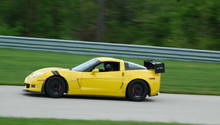Corvette: How to Build a Budget Track Corvette
The Corvette is a track worthy machine as delivered from Bowling Green, but there are a few improvements you can make on a budget that will allow you to improve your driving skills and most importantly have fun safely!
This article applies to the C5, C6 and C7 Corvette (1997-current).
The first thing you'll need to address is that all of your maintenance items up up to par paying particular attention to oil, brake fluid fuel and brake pads. Be sure that you have fresh fuel and do not run the tank too low as hard cornering or braking could uncover the pick-up and cause a lean condition. Regarding brake fluid, be sure that the fluid is fresh (if necessary flush and replace) as well as full. Oil should also be fresh and full and if you are planning on attacking a longer road course it may not be a bad idea to run the crankcase a half quart above full to ensure that on corners and braking the pick-up in the oil pan isn't starved. Brake pads are also a major consideration to keep in mind. It is not necessary to buy aftermarket brake pads (which of course you can if your budget allows and you so desire) but inspect your current pads to make sure that they have at least fifty percent of the pad remaining. Check your coolant level as your car is going to be pushed to the limit and overheating is the last thing you need to happen.

Tires are the next consideration once you decide that your general maintenance items are all in order. As long as your daily driver tires are not too worn and inflated properly there is nothing wrong with using them on your budget track car. If your tires are in need of replacement address that immediately as taking a car to the track with worn tires (i.e., no grip) can lead to disaster. If you do decide you would like to get a little more serious about either auto crossing or road racing investing in a set of "race" tires and mounting them on a spare set of OE wheels is a very good idea. Not only will you improve your track times and have a much better handling car as you push it to the limits but you also won't have to worry about wearing out your daily driver tires on hard cornering and braking.

Regarding suspension, the Corvette from the factory has an excellent suspension geometry, which manages to keep the body relatively flat, and not be overly demanding on the tires. As always, a good alignment is encouraged to promote straight tracking, predictable handling, and decent tire wear. If the budget goes beyond that, consider investing in a good set of aftermarket shocks, which can improve your car's handling immensely. Companies such as Koni, QA1 and others offer aftermarket shocks to help keep the car stable in corners, planting all four tires evenly on the ground. Many of the new "race" shocks also are very comfortable on the street for daily use. These shocks can be purchased starting around $600 for all four. While investigating shocks you can also decide if spending money on springs, control arms, etc. is in the cards for you to also help in improving handling.

Finally, and this is a good one because it is free, remove all unnecessary items from inside the car to not only lower the weight but to keep things from flying around and causing you possible injury during your driving experience. Floot mats, cell phones, loose change, water bottles, garage door openers, jacks, and so on. Look around good because anything not bolted down that can be removed should be.
Now hit the track... and have fun safely!
Related Discussions
- C7 Track Thread - CorvetteForum
- Budget Racing Seat Thread - CorvetteForum
- Budget Wheels - CorvetteForum
- C5 Track Car Build - CorvetteForum






